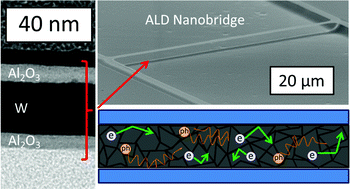Electrical and thermal conduction in ultra-thin freestanding atomic layer deposited W nanobridges†
Abstract
Work presented here measures and interprets the electrical and thermal conductivities of atomic layer deposited (ALD) free-standing single film and periodic tungsten and aluminum oxide nanobridges with thicknesses from ∼5–20 nm and ∼3–13 nm, respectively. Electrical conductivity of the W films is reduced by up to 99% from bulk, while thermal conductivity is reduced by up to 91%. Results indicate phonon contribution to thermal conductivity is dominant in these ALD films and may be substantially reduced by the incorporation of periodicity in the ALD W/Al2O3 nanolaminates. Additionally, thin film conduction modeling demonstrates nano-structured grain features largely dictate electron and phonon conduction in ALD W. New fabrication methods have allowed for the development of free-standing ultra-thin structures with layers on the order of several nanometers utilizing ALD. While the literature contains diverse studies of the physical properties of thin films prepared by traditional micro-fabrication sputtering or chemical vapor deposition techniques, there remains little data on freestanding structures containing ALD generated materials. Specifically, knowledge of the electrical and thermal conductivity of ALD generated materials will aid in the future development of ultra-thin nano-devices.


 Please wait while we load your content...
Please wait while we load your content...